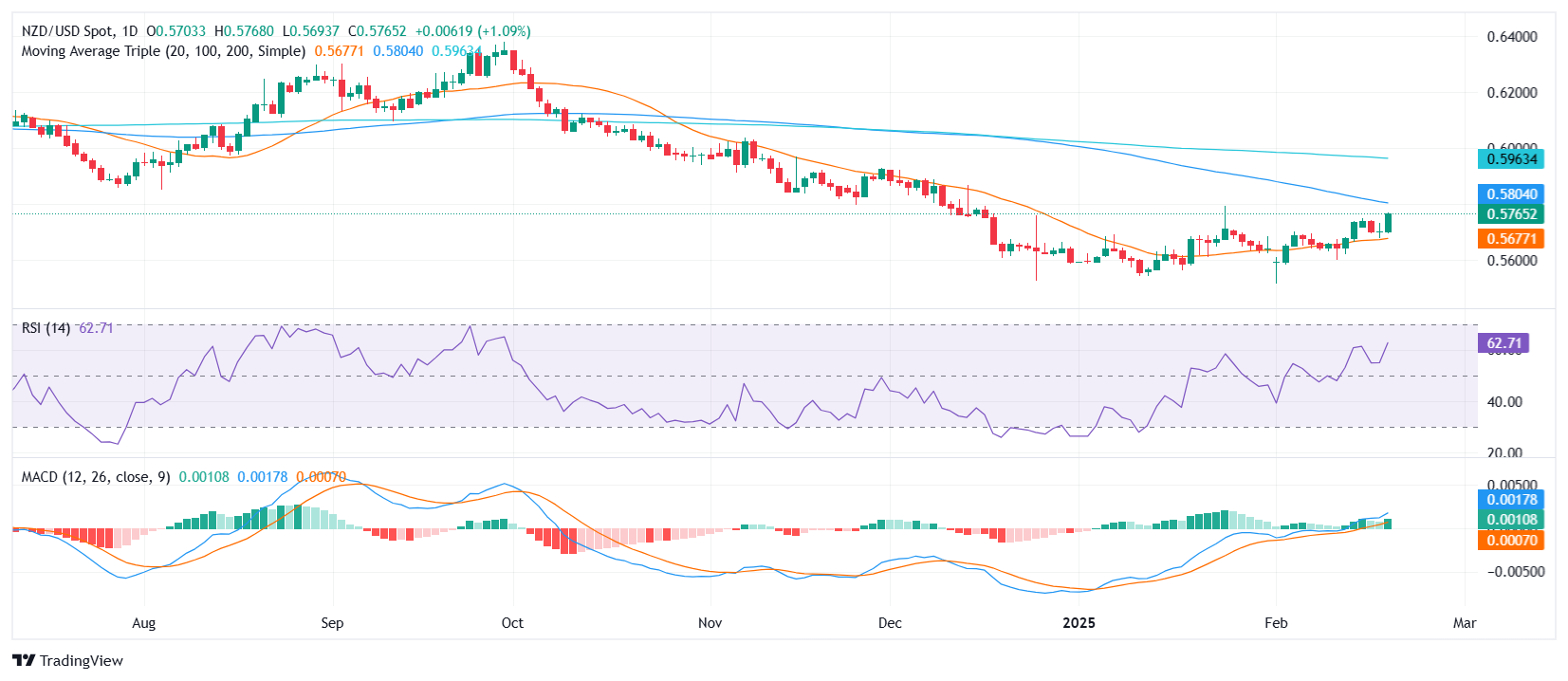- Analytics
- News and Tools
- Quotes
- Chart and quotes for NZDUSD
CFD Trading Rate New Zealand Dollar vs US Dollar (NZDUSD)
| Date | Rate | Change | |
|---|---|---|---|
| 13.04.2025 | 0.58538 | 0.51% | |
| 10.04.2025 | 0.58242 | 1.46% | |
| 09.04.2025 | 0.57405 | 1.66% | |
| 08.04.2025 | 0.56466 | 2.12% | |
| 07.04.2025 | 0.55295 | -0.28% | |
| 06.04.2025 | 0.55453 | -0.90% | |
| 03.04.2025 | 0.55954 | -3.32% | |
| 02.04.2025 | 0.57876 | 1.30% | |
| 01.04.2025 | 0.57133 | 0.24% | |
| 31.03.2025 | 0.56998 | 0.38% |
Related news
-
25.02.2025 21:43NZD/USD Price Analysis: Bears press as the pair nears key support
- NZD/USD extends its losing streak to three consecutive sessions, testing critical support levels.
- RSI remains in positive territory but declines sharply, reflecting fading bullish strength.
- The pair approaches the 20-day SMA; a sustained break below could shift the outlook to the downside.
The NZD/USD pair continued its downward trajectory on Tuesday, marking its third consecutive daily decline as it moves closer to the 20-day Simple Moving Average (SMA). Despite last week's bullish push, buyers appear to be losing momentum, and the pair is approaching a key technical threshold that could determine its short-term direction.
From a technical standpoint, the Relative Strength Index (RSI) remains in positive territory but has declined sharply, indicating that bullish momentum is weakening. Meanwhile, the Moving Average Convergence Divergence (MACD) histogram prints flat green bars, suggesting a pause in momentum as traders assess the next move.
Looking ahead, the 20-day SMA near the 0.5700 zone is the key level to watch. A decisive break below this support could confirm a shift in sentiment, potentially opening the door for deeper losses. Conversely, if buyers step in at this threshold, the pair could attempt a rebound, with immediate resistance seen around 0.5770.
NZD/USD daily chart

-
25.02.2025 10:32NZD/USD: Under mild downward pressured – UOB Group
-
25.02.2025 07:13NZD/USD holds positive ground above 0.5700 as China unveils action plan to stabilize foreign investment
-
25.02.2025 02:21NZD/USD remains subdued below 0.5750 amid a downbeat market sentiment
-
24.02.2025 10:53NZD/USD: Likely to trade sideways between 0.5735 and 0.5770 – UOB Group
-
24.02.2025 09:11NZD/USD Price Forecast: Hovers around 0.5750 near nine-day EMA support
-
24.02.2025 07:08NZD/USD jumps above 0.5750 amid prospect of Fed rate cuts
-
24.02.2025 02:18NZD/USD holds gains near 0.5750 following Retail Sales, China’s annual policy blueprint
-
21.02.2025 11:00NZD/USD: Unlikely to reach 0.5790 today – UOB Group
-
21.02.2025 06:46NZD/USD remains subdued near 0.5750 following Trade Balance data
-
21.02.2025 01:19NZD/USD posts modest gains above 0.5750 ahead of US PMI release
-
20.02.2025 21:42NZD/USD Price Analysis: Bulls surge to back to highs since January, eyeing 100-day SMA retest
-
20.02.2025 10:35NZD/USD: Upward momentum has slowed – UOB Group
-
20.02.2025 10:23NZD/USD gains to near 0.5730 as US Dollar faces selling pressure
-
20.02.2025 01:55NZD/USD weakens below 0.5700 on RBNZ’s dovish stance
-
19.02.2025 22:01NZD/USD Price Analysis: Pair holds above key support as market digests RBNZ decision
-
19.02.2025 14:38NZD/USD trades higher above 0.5700 despite RBNZ delivers dovish interest rate outlook
-
19.02.2025 09:50NZD/USD: Likely to trade sideways between 0.5690 and 0.5730 – UOB Group
-
19.02.2025 09:43NZD/USD: Pace of rate cut to slow going forward – OCBC
-
19.02.2025 08:22NZD/USD holds gains above 0.5700 as US Dollar depreciates ahead of FOMC Minutes
© 2000-2025. All rights reserved.
This site is managed by Teletrade D.J. LLC 2351 LLC 2022 (Euro House, Richmond Hill Road, Kingstown, VC0100, St. Vincent and the Grenadines).
The information on this website is for informational purposes only and does not constitute any investment advice.
The company does not serve or provide services to customers who are residents of the US, Canada, Iran, The Democratic People's Republic of Korea, Yemen and FATF blacklisted countries.
Making transactions on financial markets with marginal financial instruments opens up wide possibilities and allows investors who are willing to take risks to earn high profits, carrying a potentially high risk of losses at the same time. Therefore you should responsibly approach the issue of choosing the appropriate investment strategy, taking the available resources into account, before starting trading.
Use of the information: full or partial use of materials from this website must always be referenced to TeleTrade as the source of information. Use of the materials on the Internet must be accompanied by a hyperlink to teletrade.org. Automatic import of materials and information from this website is prohibited.
Please contact our PR department if you have any questions or need assistance at pr@teletrade.global.


















